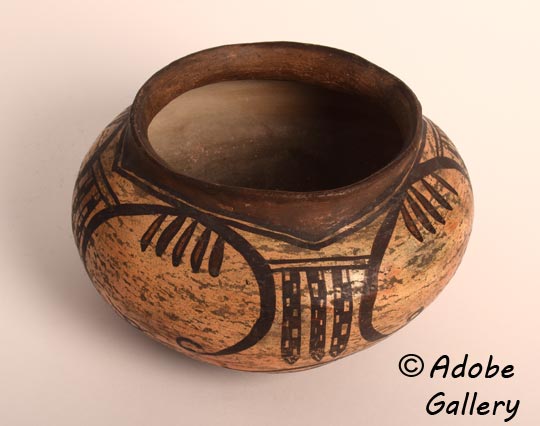Nampeyo of Hano Polacca Polychrome Jar [R]
+ Add to my watchlist Forward to Friend
Forward to Friend
- Category: Historic
- Origin: Hopi Pueblo, Hopituh Shi-nu-mu
- Medium: clay, pigment
- Size: 5” height x 8” diameter
- Item # C4904A
- Price No Longer Available
NINETEENTH CENTURY JAR BY NAMPEYO
Though never signed, Nampeyo of Hano's pottery is so distinctive and masterfully executed that attributing a piece to her is rarely difficult. This jar exemplifies her artistic brilliance, bearing all the hallmarks of her work from the Hopi Reservation.
Perfectly balanced in form, the jar features a polished underbody and a proportionate top opening. Between them, its bulbous shape reaches a full midbody diameter, capped by a gracefully curved rim slipped in red clay, mirroring the underbody. The surface is adorned with a yellow-orange slip, serving as the backdrop for the iconic Eagle Tail design, a motif rooted in the prehistoric Sikyatki culture. With a subtly rounded base, the jar sits at a slight tilt.
Nampeyo drew inspiration from the ancient pottery shards she uncovered at Sikyatki, using them as a foundation to develop her own distinctive designs. She had started making pottery when she was a teenager and she rapidly adapted and mastered the techniques, being recognized early in life as an exceptional potter.
Nampeyo became the most famous potter at Hopi some three decades before Maria Martinez became a famous potter from San Ildefonso. Nampeyo, therefore, is the first modern pueblo potter to achieve fame. Hopi culture discourages individuals from being above others of the village. Their beliefs are that everyone participates in their culture and no one stands alone. Nampeyo was descended from Tewa Indians of New Mexico who migrated to Hopi after the Pueblo Revolt, and the group was given a village at First Mesa as their own. Since Nampeyo was a Hopi-Tewa rather than of ancestral Hopi origin, and given the Hopi perspective on individuality, she may not have been fully recognized as an exceptional person within her own pueblo.
Nampeyo was more than a potter. She was an outstanding artist who created some of the most magnificent pottery of the nineteenth and twentieth centuries. Yet, she was also a pueblo woman who carried out the duties expected of her. She was a wife, a mother, an artist, and a member of her community. Recognizing her talent, Thomas Keam became an early advocate of her work, introducing her to collectors. Nampeyo did not speak English. She spoke Tewa. Her brother, Tom Polacca, was her go-between to Keam.
Nampeyo later caught the attention of The Fred Harvey Company, which built her a Hopi-style home at the Grand Canyon, where she spent two summers demonstrating her pottery techniques to an admiring public. Through her innovation, skill, and dedication, Nampeyo secured her place as one of the most important potters of the 19th and 20th centuries.
Condition: very good condition
Provenance: this Nampeyo of Hano Polacca Polychrome Jar is from a private collection
Recommended Reading: The Legacy of a Master Potter - Nampeyo and Her Descendants by Mary Ellen and Laurence Blair
TAGS: Hopi Pueblo, Fannie Polacca Nampeyo, Nellie Nampeyo Douma, Annie Healing Nampeyo, Nampeyo of Hano, Hopi-Tewa Potter and Matriarch

- Category: Historic
- Origin: Hopi Pueblo, Hopituh Shi-nu-mu
- Medium: clay, pigment
- Size: 5” height x 8” diameter
- Item # C4904A
- Price No Longer Available
Adobe Gallery Recommended Reading
Adobe Gallery Recommended Items
If you are interested in this item, we would also like to recommend these other related items:



